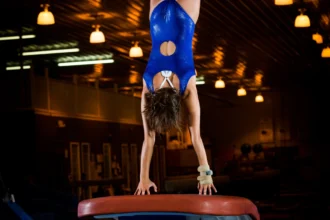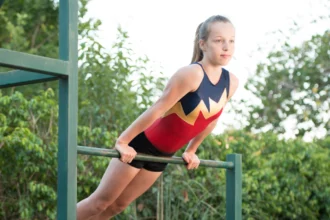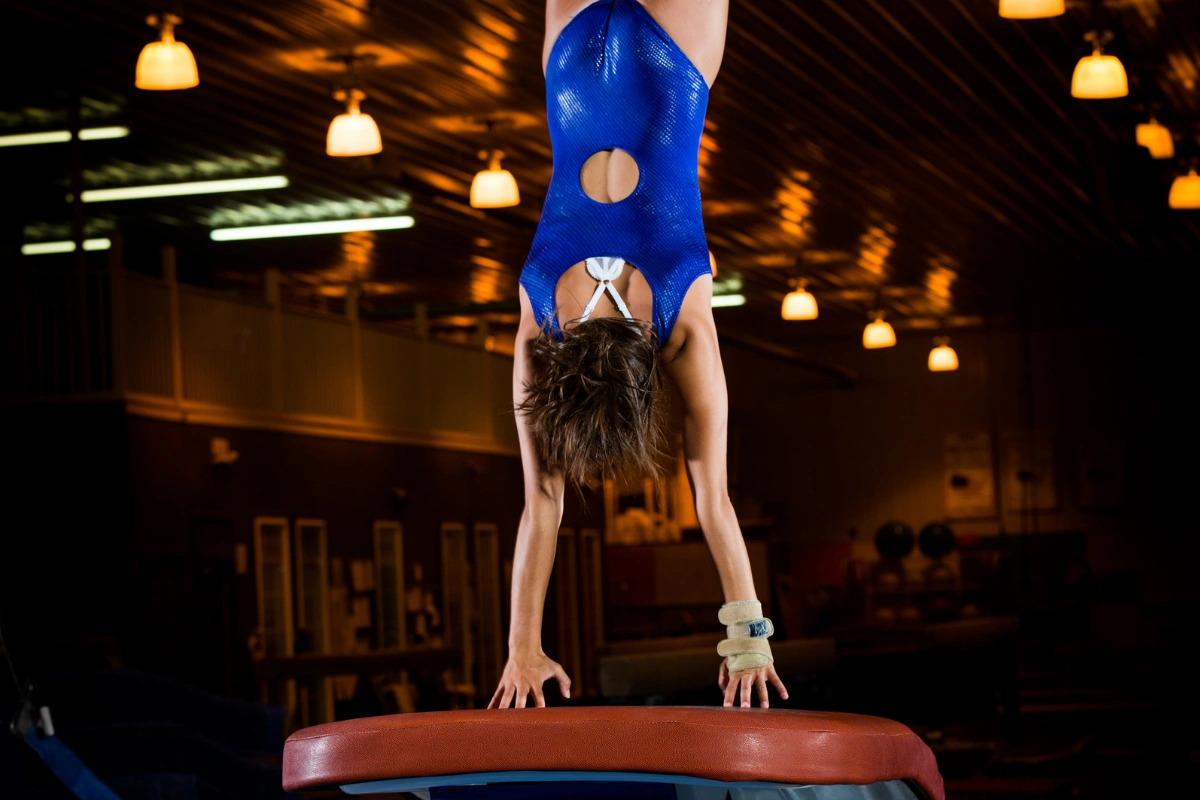The Produnova vault, named after Russian gymnast Yelena Produnova, is renowned for its exceptional difficulty and the significant risks it poses to gymnasts. First performed by Produnova at the 1999 Summer Universiade in Palma de Mallorca, Spain, this vault quickly became one of the most discussed elements in gymnastics.
The Produnova vault is an incredibly complex and powerful move. Unlike the traditional vaults performed by gymnasts, which often feature a back handspring or other rotations, the Produnova involves two forward somersaults, making it a unique and formidable maneuver.
Execution Steps:
- Approach and Launch: The gymnast sprints toward the vaulting table, building maximum speed. The initial push-off demands exceptional strength and technique to propel the body with sufficient force.
- Double Front Somersault with Half Twist: Upon launch, the gymnast performs two forward somersaults in the air, simultaneously executing a half twist. This combination requires precise body control, power, and timing.
- Landing: The vault concludes with the gymnast landing on their feet after completing the double front somersault with the half twist. Given the height and speed involved, a misstep can lead to serious injury.
Why is the Produnova So Dangerous?
The Produnova is not just dangerous because of its complexity, but because of the immense risks involved in performing the vault at full speed and height. Several key factors contribute to the inherent danger of this move:
1. High Velocity and Power
One of the most dangerous aspects of the Produnova is the immense power required to perform it. To achieve the necessary speed and height, the gymnast needs to sprint incredibly fast toward the vaulting table and then push off with great force.
If this power is not properly controlled, the gymnast may lose control mid-air or fail to reach the height needed for a safe landing.
2. Complex Aerial Movements
As the gymnast launches into the air, they must complete two full rotations and a half-twist. This level of aerial complexity is extremely difficult to manage, especially when the gymnast is in such a vulnerable position high above the mat.
The higher the altitude reached during the vault, the more time the gymnast has to rotate and twist, which increases the risk of misjudging the distance or timing required to land safely.
3. Limited Time to Correct Mistakes
During the vault, gymnasts have very little time to adjust or correct errors. A mistake at the start of the vault – whether it’s the initial speed, the hand placement, or the lift-off – can quickly snowball into a catastrophic landing or injury.
In fact, gymnasts have been injured during or after executing the Produnova due to miscalculations.
4. High-Impact Landing
The final landing of the Produnova vault is crucial. Because of the height and speed involved, if the gymnast doesn’t land perfectly, the impact on the body is severe.
Gymnasts need to land with enough control to prevent injury from the high-impact forces, but a misstep can lead to serious consequences, including broken bones, sprains, or torn ligaments.
The Produnova Vault’s Difficulty Rating
The Produnova vault, named after Russian gymnast Yelena Produnova, is famous for its extreme difficulty and high risk. When it was first introduced, it was assigned a difficulty rating of 7.1, reflecting its status as one of the most challenging vaults in gymnastics.
However, as the sport has evolved and safety concerns have come into focus, the difficulty rating has been adjusted over the years:
- 2013–2016: The difficulty rating was set at 7.0 points.
- 2017–2020: The rating was reduced to 6.4 points, reflecting a more refined understanding of the vault’s complexity.
- 2022–2024: The rating was further reduced to 6.0 points, aligning with continued efforts to ensure gymnast safety and reflect the evolving demands of the vault.
Despite these reductions, the Produnova remains one of the most technically demanding vaults in gymnastics. It continues to require unparalleled power, precision, and timing, and its high difficulty rating still underscores the extraordinary skill needed to execute it safely.
Who Has Performed the Produnova Vault?
Over the years, very few gymnasts have attempted the Produnova in major competitions, with only a handful of brave athletes successfully landing it. Notable gymnasts who have executed the Produnova include:
Yamilet Peña (Dominican Republic)
- Peña made history by becoming the first gymnast to successfully perform the Produnova in competition. She achieved this feat at the 2011 World Championships in Tokyo, where she qualified third in the vault event with a score of 14.466. Despite a subsequent fall in the final, Peña’s execution of the Produnova marked a significant milestone in gymnastics.
Fadwa Mahmoud (Egypt)
- Mahmoud attempted the Produnova at the 2014 World Cup in Doha. Her first attempt was unsuccessful, but she made a successful second attempt, scoring 14.950. This performance highlighted her courage and technical skill, as executing the Produnova requires exceptional strength and precision.
Dipa Karmakar (India)
- Karmakar gained international acclaim for her execution of the Produnova, becoming the first Indian gymnast to perform this vault in competition. She achieved this at the 2014 Commonwealth Games in Glasgow, where she secured a bronze medal. Her successful execution of the Produnova brought her widespread recognition and inspired many aspiring gymnasts.
Oksana Chusovitina (Uzbekistan)
- Chusovitina, a veteran gymnast with a career spanning over two decades, attempted the Produnova at the 2016 Summer Olympics in Rio de Janeiro. Although she did not land the vault successfully, her attempt underscored her enduring commitment to the sport and her willingness to challenge herself with high-difficulty elements.
The Produnova vault remains one of the most awe-inspiring, yet perilous, elements in gymnastics. Its combination of strength, speed, and precision makes it a true test of a gymnast’s abilities.
While its difficulty rating has been reduced over the years, the vault’s immense complexity continues to challenge athletes at the highest levels.





